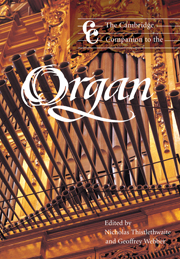Book contents
- Frontmatter
- Part I The instrument
- Part II The player
- Part III Selected repertoires
- 10 Italian organ music to Frescobaldi
- 11 Iberian organ music before 1700
- 12 The French classical organ school
- 13 English organ music to c1700
- 14 Catholic Germany and Austria 1648–c1800
- 15 The north German organ school
- 16 The organ music of J. S. Bach
- 17 German organ music after 1800
- 18 French and Belgian organ music after 1800
- 19 British organ music after 1800
- 20 North American organ music after 1800
- Appendix: The modes (toni) and their attributes according to Zarlino
- Notes
- Bibliography
- Index
16 - The organ music of J. S. Bach
from Part III - Selected repertoires
Published online by Cambridge University Press: 28 September 2011
- Frontmatter
- Part I The instrument
- Part II The player
- Part III Selected repertoires
- 10 Italian organ music to Frescobaldi
- 11 Iberian organ music before 1700
- 12 The French classical organ school
- 13 English organ music to c1700
- 14 Catholic Germany and Austria 1648–c1800
- 15 The north German organ school
- 16 The organ music of J. S. Bach
- 17 German organ music after 1800
- 18 French and Belgian organ music after 1800
- 19 British organ music after 1800
- 20 North American organ music after 1800
- Appendix: The modes (toni) and their attributes according to Zarlino
- Notes
- Bibliography
- Index
Summary
Johann Sebastian Bach spent almost his entire life in a small region of central Germany whose boundaries are marked by the town of his birth, Eisenach in Thuringia, and the place of his death, the Saxon city of Leipzig, which lies only one hundred miles to the east. Unlike his famous contemporary Handel, who was also born in the region, Bach did not venture beyond this relatively confined area save for two years spent as a chorister in the north German city of Lüneburg, and occasional trips to the important musical centres of Lübeck, Hamburg, Dresden and Berlin. But Bach's music stands in counterpoint to the provinciality of his biography; his organ works encompass an unprecedented range of diverse traditions, demonstrating a mastery of the organ art that flourished in his native Thuringia, a fluency in the flamboyant language of north German organ playing of the preceding generation, and a profound knowledge of French and Italian idioms, the dominant national styles of the eighteenth century. Bach transformed and synthesised techniques and styles ranging from the stile antico of renaissance polyphony to the most up-to-date thrills of Italian orchestral writing.
According to C. P. E. Bach his father had been exposed to a wide range of music from an early age: he had studied the music of ‘some old and good Frenchmen’, Italian and south German composers of the seventeenth century including Girolamo Frescobaldi, Johann Pachelbel, Johann Jakob Froberger, Johann Caspar Kerll, Nicolaus Adam Strungk, and the most important north German organists of the period – Dieterich Buxtehude, Johann Adam Reincken, Nicolaus Bruhns, and Georg Böhm (David and Mendel 1966: 278).
- Type
- Chapter
- Information
- The Cambridge Companion to the Organ , pp. 236 - 249Publisher: Cambridge University PressPrint publication year: 1999



